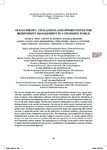Ocean sprawl: challenges and opportunities for biodiversity management in a changing world
| dc.contributor.author | Firth, Louise | |
| dc.contributor.author | Knights, Antony | |
| dc.contributor.author | Bridger, Danielle | |
| dc.contributor.author | Evans, A | |
| dc.contributor.author | Mieskowska, N | |
| dc.contributor.author | Moore, PJ | |
| dc.contributor.author | O'Connor, NE | |
| dc.contributor.author | Sheehan, Emma | |
| dc.contributor.author | Thompson, Richard | |
| dc.contributor.author | Hawkins, SJ | |
| dc.date.accessioned | 2016-11-25T13:01:01Z | |
| dc.date.available | 2016-11-25T13:01:01Z | |
| dc.date.issued | 2016-11-25 | |
| dc.identifier.issn | 0078-3218 | |
| dc.identifier.uri | http://hdl.handle.net/10026.1/8025 | |
| dc.description.abstract |
The last few decades have seen rapid proliferation of hard artificial structures (e.g., energy infrastructure, aquaculture, coastal defences) in the marine environment: ocean sprawl. The replacement of natural, often sedimentary, substrata with hard substrata has altered the distribution of species, particularly non-indigenous species, and can facilitate the assisted migration of native species at risk from climate change. This has been likened to urbanization as a driver of global biotic homogenization in the marine environment-the process by which species invasions and extinctions increase the genetic, taxonomic, or functional similarity of communities at local, regional, and global scales. Ecological engineering research showed that small-scale engineering interventions can have a significant positive effect on the biodiversity associated with artificial structures, promoting more diverse and resilient communities on local scales. This knowledge can be applied to the design of multifunctional structures that provide a range of ecosystem services. In coastal regions, hybrid designs can work with nature to combine hard and soft approaches to coastal defence in a more environmentally sensitive manner. The challenge now is to manage ocean sprawl with the dual goal of supporting human populations and activities, simultaneously strengthening ecosystem resilience using an ecosystem-based approach. | |
| dc.format.extent | ? - ? (78) | |
| dc.language.iso | en | |
| dc.publisher | Aberdeen University Press | |
| dc.title | Ocean sprawl: challenges and opportunities for biodiversity management in a changing world | |
| dc.type | journal-article | |
| dc.type | Chapter | |
| plymouth.author-url | https://www.webofscience.com/api/gateway?GWVersion=2&SrcApp=PARTNER_APP&SrcAuth=LinksAMR&KeyUT=WOS:000397060700004&DestLinkType=FullRecord&DestApp=ALL_WOS&UsrCustomerID=11bb513d99f797142bcfeffcc58ea008 | |
| plymouth.volume | 54 | |
| plymouth.publication-status | Published online | |
| plymouth.journal | Oceanography and Marine Biology: an annual review | |
| dc.identifier.doi | 10.1201/9781315368597 | |
| plymouth.organisational-group | /Plymouth | |
| plymouth.organisational-group | /Plymouth/Faculty of Science and Engineering | |
| plymouth.organisational-group | /Plymouth/Faculty of Science and Engineering/School of Biological and Marine Sciences | |
| plymouth.organisational-group | /Plymouth/PRIMaRE Publications | |
| plymouth.organisational-group | /Plymouth/REF 2021 Researchers by UoA | |
| plymouth.organisational-group | /Plymouth/REF 2021 Researchers by UoA/UoA07 Earth Systems and Environmental Sciences | |
| plymouth.organisational-group | /Plymouth/Research Groups | |
| plymouth.organisational-group | /Plymouth/Research Groups/Marine Institute | |
| plymouth.organisational-group | /Plymouth/Users by role | |
| plymouth.organisational-group | /Plymouth/Users by role/Academics | |
| plymouth.organisational-group | /Plymouth/Users by role/Researchers in ResearchFish submission | |
| dcterms.dateAccepted | 2016-06-20 | |
| dc.rights.embargoperiod | Not known | |
| rioxxterms.versionofrecord | 10.1201/9781315368597 | |
| rioxxterms.licenseref.uri | http://www.rioxx.net/licenses/all-rights-reserved | |
| rioxxterms.licenseref.startdate | 2016-11-25 | |
| rioxxterms.type | Journal Article/Review |


